Developing a Booklet on Diverse Cultures and Languages in Childhood
VerifiedAdded on 2022/10/09
|12
|2421
|15
Project
AI Summary
This project presents an educational booklet designed for early childhood educators, focusing on the exploration of diverse cultures and languages within early learning environments. The booklet, developed by a student, emphasizes the critical role educators play in supporting children and families from varied cultural backgrounds. It explores pedagogical practices to enhance language and literacy development, offering strategies for creating inclusive settings where all children feel connected and can thrive. The content covers the benefits of exploring different cultures and languages, providing practical examples and strategies for teachers. The booklet also provides advice on creating safe spaces for interaction, offering information about different cultures, and encouraging exploration. The booklet is designed to help teachers understand their students better and overcome language barriers. The project also includes references to support the information and aid educators in their practice.
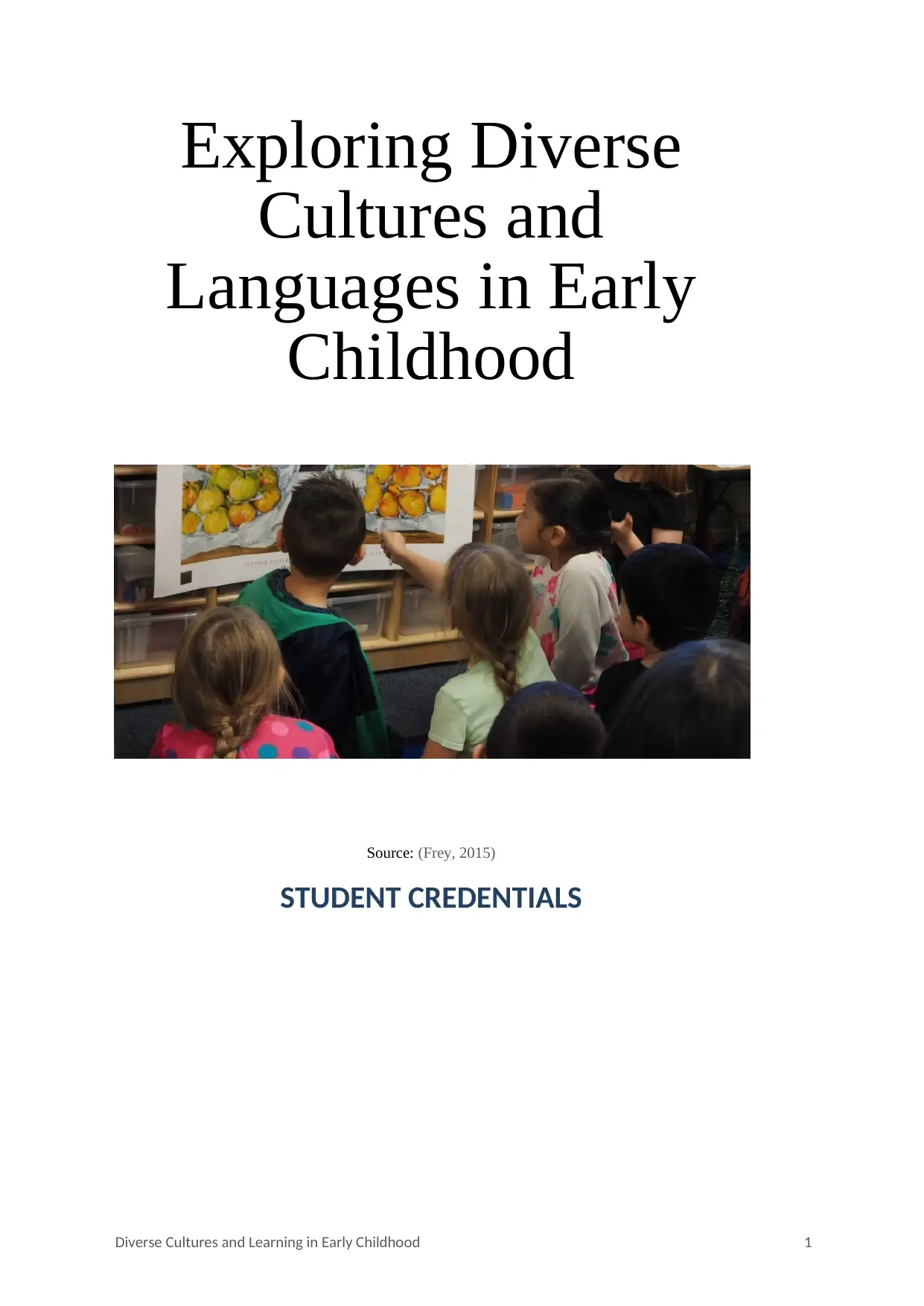
Exploring Diverse
Cultures and
Languages in Early
Childhood
Source: (Frey, 2015)
STUDENT CREDENTIALS
Diverse Cultures and Learning in Early Childhood 1
Cultures and
Languages in Early
Childhood
Source: (Frey, 2015)
STUDENT CREDENTIALS
Diverse Cultures and Learning in Early Childhood 1
Paraphrase This Document
Need a fresh take? Get an instant paraphrase of this document with our AI Paraphraser
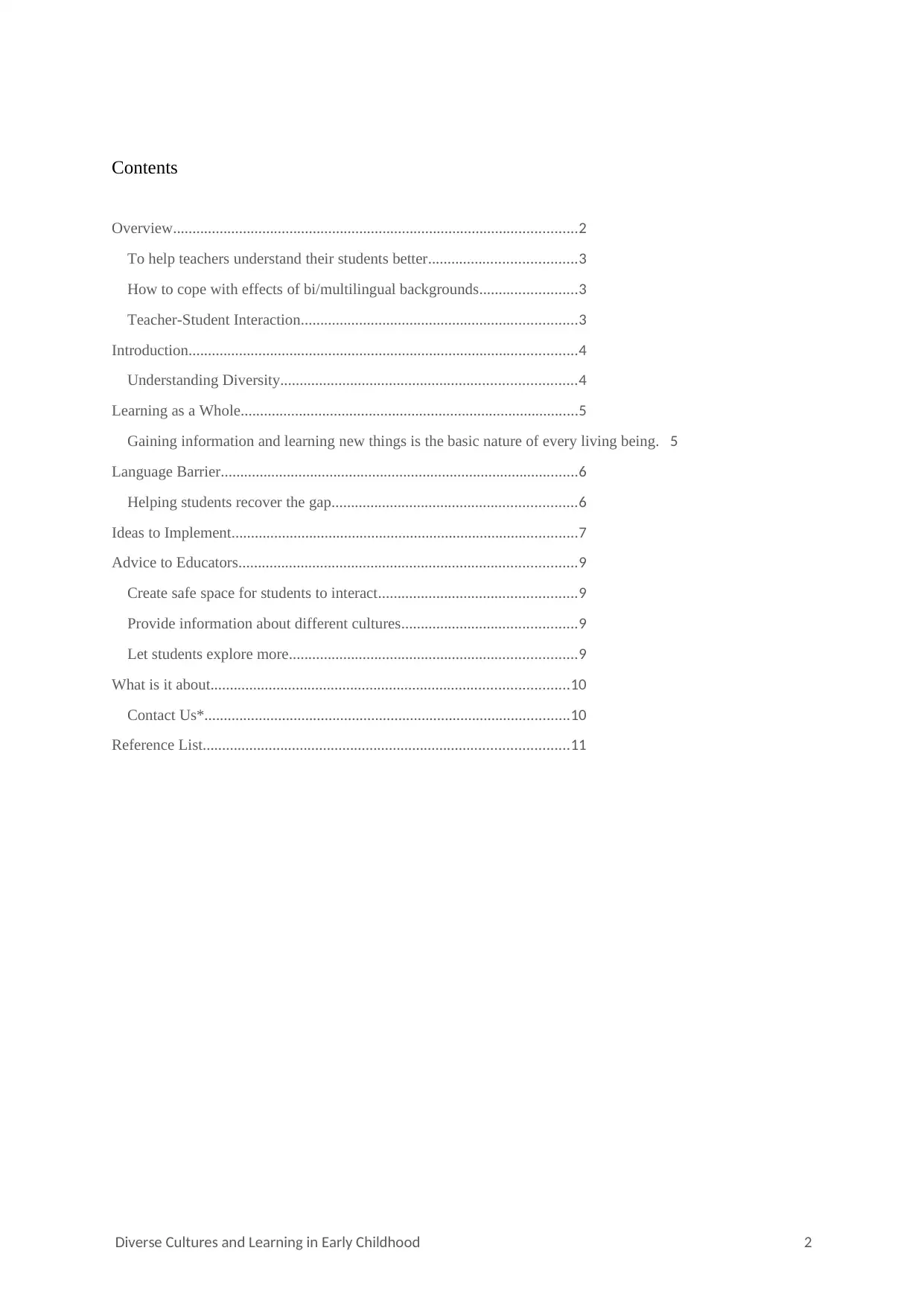
Contents
Overview........................................................................................................2
To help teachers understand their students better......................................3
How to cope with effects of bi/multilingual backgrounds.........................3
Teacher-Student Interaction.......................................................................3
Introduction....................................................................................................4
Understanding Diversity............................................................................4
Learning as a Whole.......................................................................................5
Gaining information and learning new things is the basic nature of every living being. 5
Language Barrier............................................................................................6
Helping students recover the gap...............................................................6
Ideas to Implement.........................................................................................7
Advice to Educators.......................................................................................9
Create safe space for students to interact...................................................9
Provide information about different cultures.............................................9
Let students explore more..........................................................................9
What is it about............................................................................................10
Contact Us*..............................................................................................10
Reference List..............................................................................................11
Diverse Cultures and Learning in Early Childhood 2
Overview........................................................................................................2
To help teachers understand their students better......................................3
How to cope with effects of bi/multilingual backgrounds.........................3
Teacher-Student Interaction.......................................................................3
Introduction....................................................................................................4
Understanding Diversity............................................................................4
Learning as a Whole.......................................................................................5
Gaining information and learning new things is the basic nature of every living being. 5
Language Barrier............................................................................................6
Helping students recover the gap...............................................................6
Ideas to Implement.........................................................................................7
Advice to Educators.......................................................................................9
Create safe space for students to interact...................................................9
Provide information about different cultures.............................................9
Let students explore more..........................................................................9
What is it about............................................................................................10
Contact Us*..............................................................................................10
Reference List..............................................................................................11
Diverse Cultures and Learning in Early Childhood 2
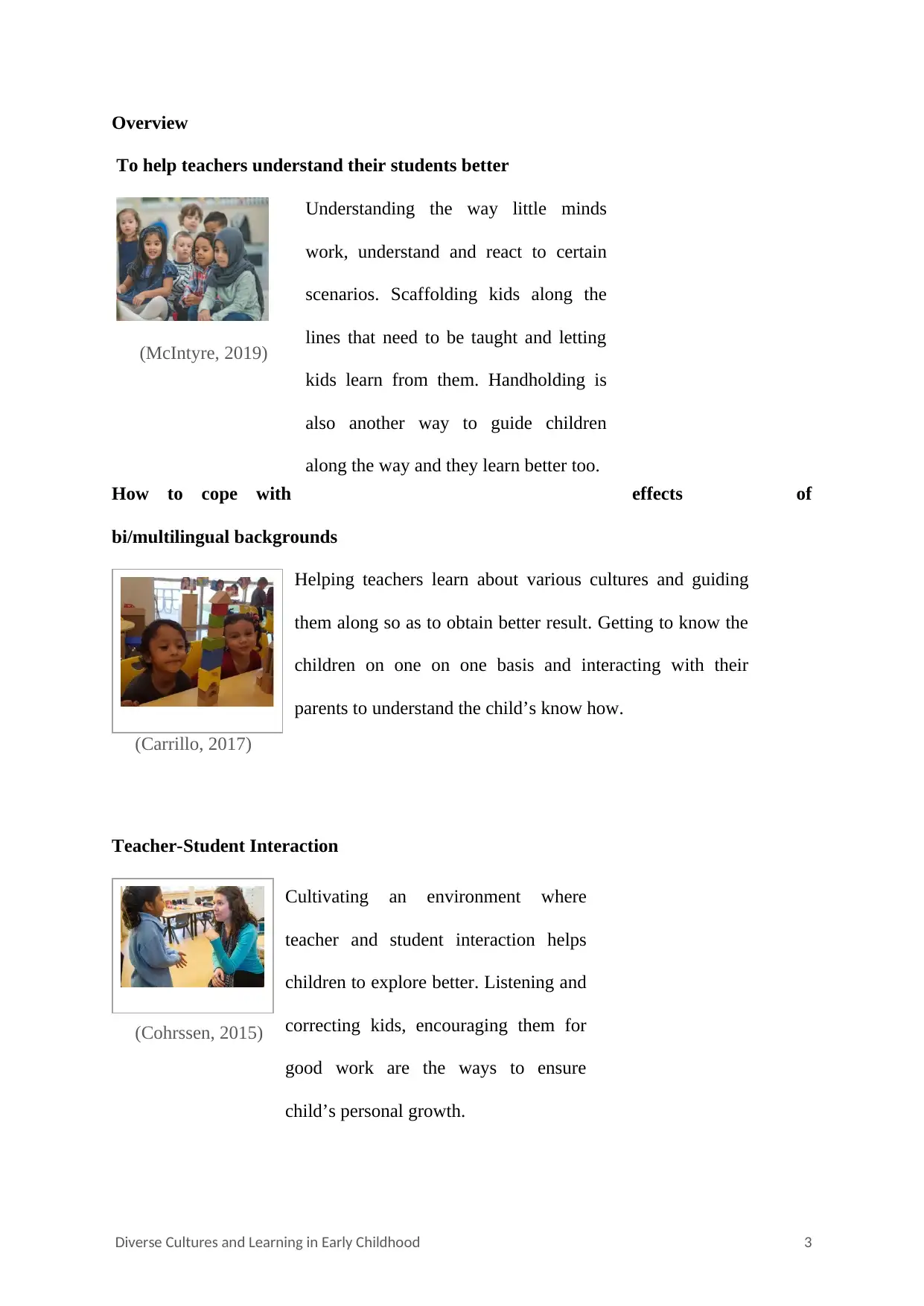
Overview
To help teachers understand their students better
(McIntyre, 2019)
How to cope with effects of
bi/multilingual backgrounds
(Carrillo, 2017)
Helping teachers learn about various cultures and guiding
them along so as to obtain better result. Getting to know the
children on one on one basis and interacting with their
parents to understand the child’s know how.
Teacher-Student Interaction
(Cohrssen, 2015)
Cultivating an environment where
teacher and student interaction helps
children to explore better. Listening and
correcting kids, encouraging them for
good work are the ways to ensure
child’s personal growth.
Diverse Cultures and Learning in Early Childhood 3
Understanding the way little minds
work, understand and react to certain
scenarios. Scaffolding kids along the
lines that need to be taught and letting
kids learn from them. Handholding is
also another way to guide children
along the way and they learn better too.
To help teachers understand their students better
(McIntyre, 2019)
How to cope with effects of
bi/multilingual backgrounds
(Carrillo, 2017)
Helping teachers learn about various cultures and guiding
them along so as to obtain better result. Getting to know the
children on one on one basis and interacting with their
parents to understand the child’s know how.
Teacher-Student Interaction
(Cohrssen, 2015)
Cultivating an environment where
teacher and student interaction helps
children to explore better. Listening and
correcting kids, encouraging them for
good work are the ways to ensure
child’s personal growth.
Diverse Cultures and Learning in Early Childhood 3
Understanding the way little minds
work, understand and react to certain
scenarios. Scaffolding kids along the
lines that need to be taught and letting
kids learn from them. Handholding is
also another way to guide children
along the way and they learn better too.
⊘ This is a preview!⊘
Do you want full access?
Subscribe today to unlock all pages.

Trusted by 1+ million students worldwide
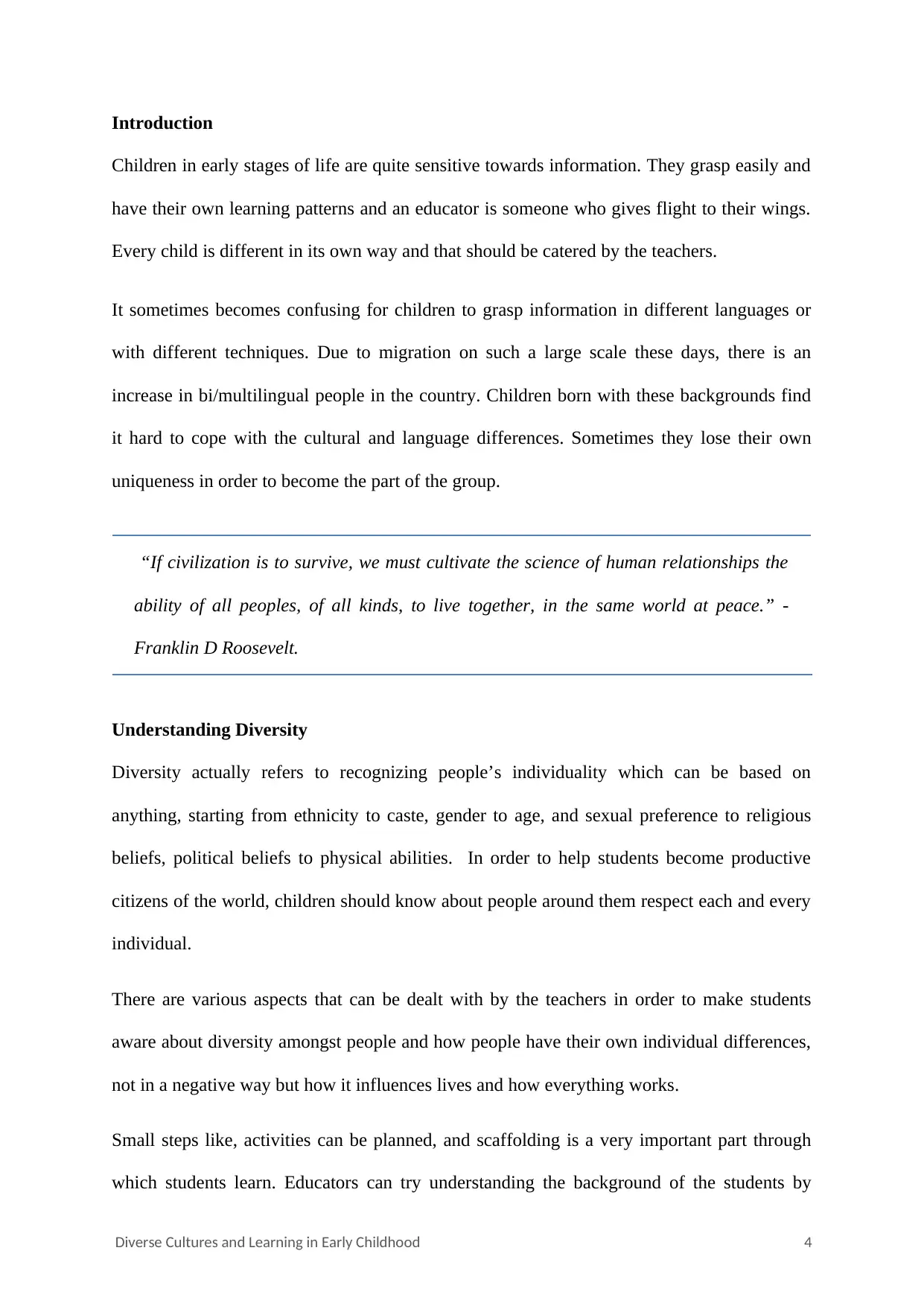
Introduction
Children in early stages of life are quite sensitive towards information. They grasp easily and
have their own learning patterns and an educator is someone who gives flight to their wings.
Every child is different in its own way and that should be catered by the teachers.
It sometimes becomes confusing for children to grasp information in different languages or
with different techniques. Due to migration on such a large scale these days, there is an
increase in bi/multilingual people in the country. Children born with these backgrounds find
it hard to cope with the cultural and language differences. Sometimes they lose their own
uniqueness in order to become the part of the group.
“If civilization is to survive, we must cultivate the science of human relationships the
ability of all peoples, of all kinds, to live together, in the same world at peace.” -
Franklin D Roosevelt.
Understanding Diversity
Diversity actually refers to recognizing people’s individuality which can be based on
anything, starting from ethnicity to caste, gender to age, and sexual preference to religious
beliefs, political beliefs to physical abilities. In order to help students become productive
citizens of the world, children should know about people around them respect each and every
individual.
There are various aspects that can be dealt with by the teachers in order to make students
aware about diversity amongst people and how people have their own individual differences,
not in a negative way but how it influences lives and how everything works.
Small steps like, activities can be planned, and scaffolding is a very important part through
which students learn. Educators can try understanding the background of the students by
Diverse Cultures and Learning in Early Childhood 4
Children in early stages of life are quite sensitive towards information. They grasp easily and
have their own learning patterns and an educator is someone who gives flight to their wings.
Every child is different in its own way and that should be catered by the teachers.
It sometimes becomes confusing for children to grasp information in different languages or
with different techniques. Due to migration on such a large scale these days, there is an
increase in bi/multilingual people in the country. Children born with these backgrounds find
it hard to cope with the cultural and language differences. Sometimes they lose their own
uniqueness in order to become the part of the group.
“If civilization is to survive, we must cultivate the science of human relationships the
ability of all peoples, of all kinds, to live together, in the same world at peace.” -
Franklin D Roosevelt.
Understanding Diversity
Diversity actually refers to recognizing people’s individuality which can be based on
anything, starting from ethnicity to caste, gender to age, and sexual preference to religious
beliefs, political beliefs to physical abilities. In order to help students become productive
citizens of the world, children should know about people around them respect each and every
individual.
There are various aspects that can be dealt with by the teachers in order to make students
aware about diversity amongst people and how people have their own individual differences,
not in a negative way but how it influences lives and how everything works.
Small steps like, activities can be planned, and scaffolding is a very important part through
which students learn. Educators can try understanding the background of the students by
Diverse Cultures and Learning in Early Childhood 4
Paraphrase This Document
Need a fresh take? Get an instant paraphrase of this document with our AI Paraphraser
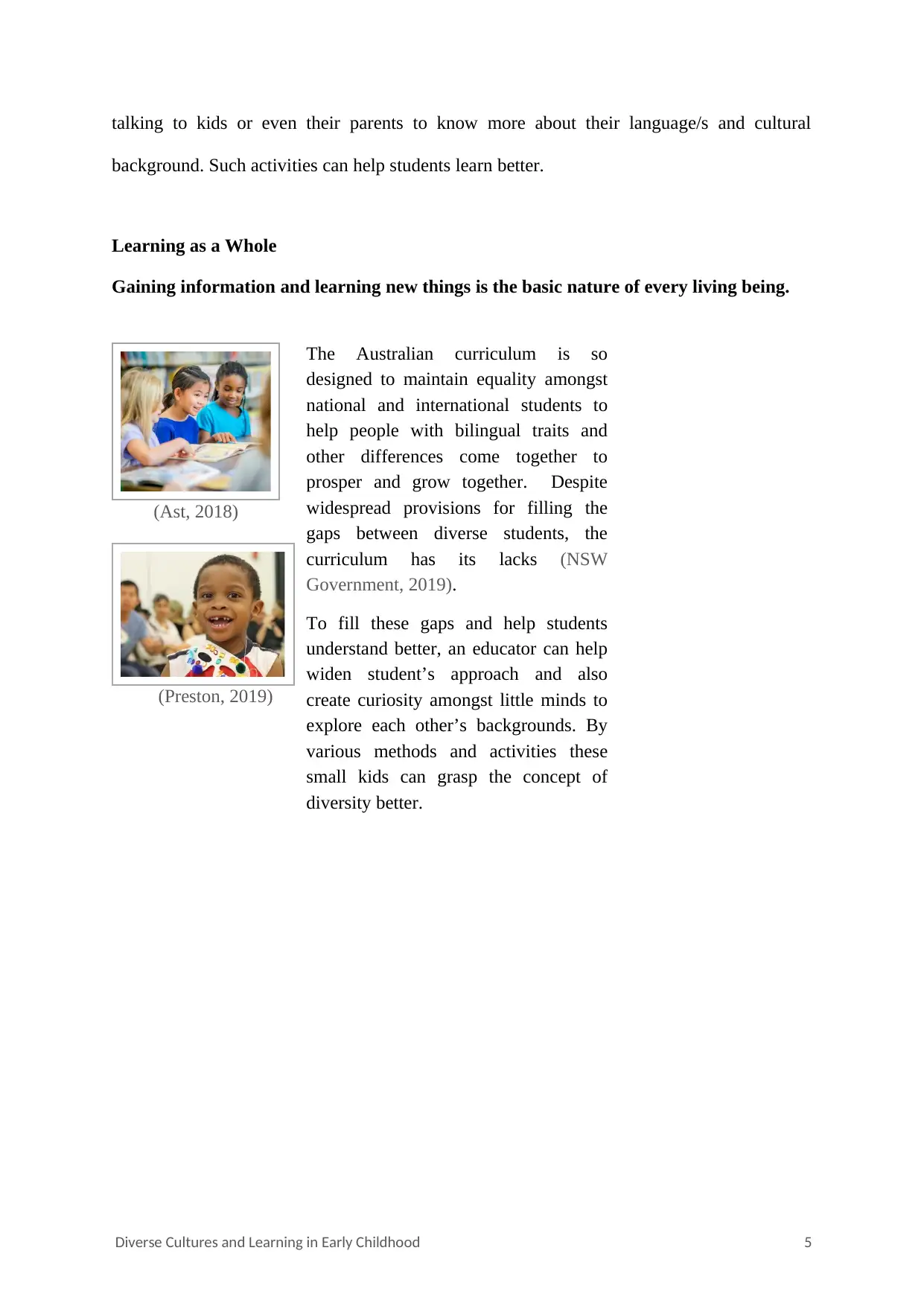
talking to kids or even their parents to know more about their language/s and cultural
background. Such activities can help students learn better.
Learning as a Whole
Gaining information and learning new things is the basic nature of every living being.
(Ast, 2018)
(Preston, 2019)
The Australian curriculum is so
designed to maintain equality amongst
national and international students to
help people with bilingual traits and
other differences come together to
prosper and grow together. Despite
widespread provisions for filling the
gaps between diverse students, the
curriculum has its lacks (NSW
Government, 2019).
To fill these gaps and help students
understand better, an educator can help
widen student’s approach and also
create curiosity amongst little minds to
explore each other’s backgrounds. By
various methods and activities these
small kids can grasp the concept of
diversity better.
Diverse Cultures and Learning in Early Childhood 5
background. Such activities can help students learn better.
Learning as a Whole
Gaining information and learning new things is the basic nature of every living being.
(Ast, 2018)
(Preston, 2019)
The Australian curriculum is so
designed to maintain equality amongst
national and international students to
help people with bilingual traits and
other differences come together to
prosper and grow together. Despite
widespread provisions for filling the
gaps between diverse students, the
curriculum has its lacks (NSW
Government, 2019).
To fill these gaps and help students
understand better, an educator can help
widen student’s approach and also
create curiosity amongst little minds to
explore each other’s backgrounds. By
various methods and activities these
small kids can grasp the concept of
diversity better.
Diverse Cultures and Learning in Early Childhood 5
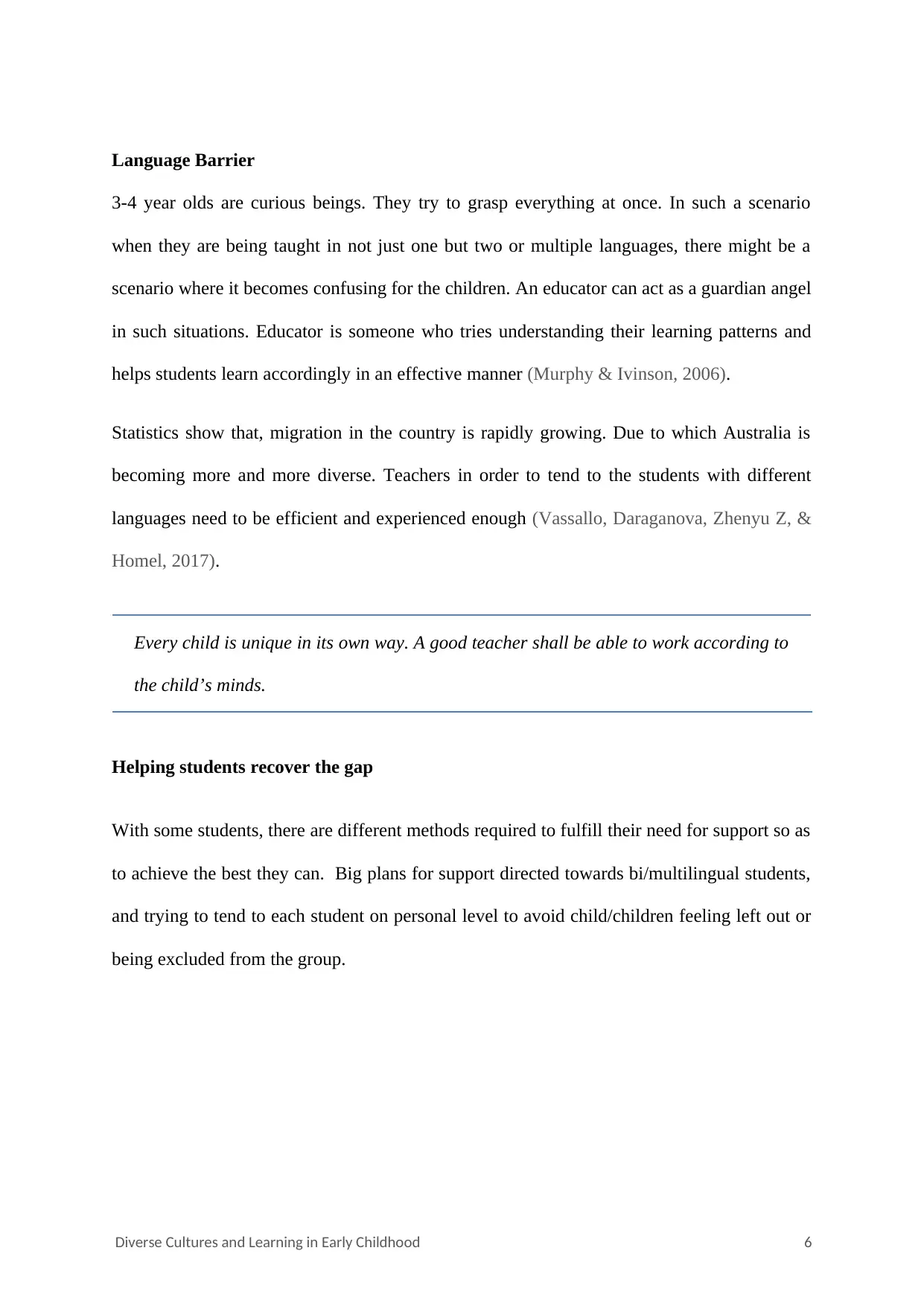
Language Barrier
3-4 year olds are curious beings. They try to grasp everything at once. In such a scenario
when they are being taught in not just one but two or multiple languages, there might be a
scenario where it becomes confusing for the children. An educator can act as a guardian angel
in such situations. Educator is someone who tries understanding their learning patterns and
helps students learn accordingly in an effective manner (Murphy & Ivinson, 2006).
Statistics show that, migration in the country is rapidly growing. Due to which Australia is
becoming more and more diverse. Teachers in order to tend to the students with different
languages need to be efficient and experienced enough (Vassallo, Daraganova, Zhenyu Z, &
Homel, 2017).
Every child is unique in its own way. A good teacher shall be able to work according to
the child’s minds.
Helping students recover the gap
With some students, there are different methods required to fulfill their need for support so as
to achieve the best they can. Big plans for support directed towards bi/multilingual students,
and trying to tend to each student on personal level to avoid child/children feeling left out or
being excluded from the group.
Diverse Cultures and Learning in Early Childhood 6
3-4 year olds are curious beings. They try to grasp everything at once. In such a scenario
when they are being taught in not just one but two or multiple languages, there might be a
scenario where it becomes confusing for the children. An educator can act as a guardian angel
in such situations. Educator is someone who tries understanding their learning patterns and
helps students learn accordingly in an effective manner (Murphy & Ivinson, 2006).
Statistics show that, migration in the country is rapidly growing. Due to which Australia is
becoming more and more diverse. Teachers in order to tend to the students with different
languages need to be efficient and experienced enough (Vassallo, Daraganova, Zhenyu Z, &
Homel, 2017).
Every child is unique in its own way. A good teacher shall be able to work according to
the child’s minds.
Helping students recover the gap
With some students, there are different methods required to fulfill their need for support so as
to achieve the best they can. Big plans for support directed towards bi/multilingual students,
and trying to tend to each student on personal level to avoid child/children feeling left out or
being excluded from the group.
Diverse Cultures and Learning in Early Childhood 6
⊘ This is a preview!⊘
Do you want full access?
Subscribe today to unlock all pages.

Trusted by 1+ million students worldwide
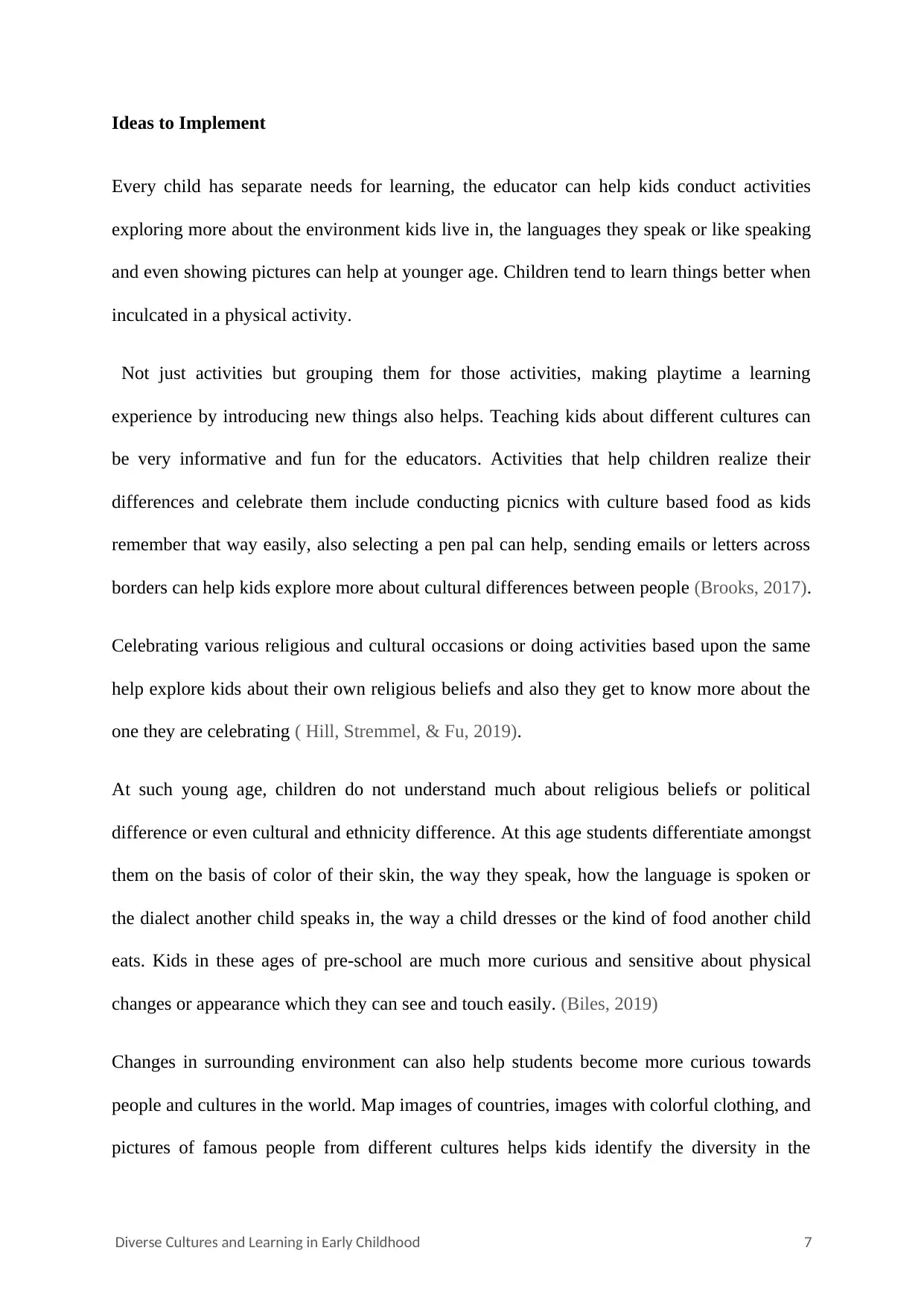
Ideas to Implement
Every child has separate needs for learning, the educator can help kids conduct activities
exploring more about the environment kids live in, the languages they speak or like speaking
and even showing pictures can help at younger age. Children tend to learn things better when
inculcated in a physical activity.
Not just activities but grouping them for those activities, making playtime a learning
experience by introducing new things also helps. Teaching kids about different cultures can
be very informative and fun for the educators. Activities that help children realize their
differences and celebrate them include conducting picnics with culture based food as kids
remember that way easily, also selecting a pen pal can help, sending emails or letters across
borders can help kids explore more about cultural differences between people (Brooks, 2017).
Celebrating various religious and cultural occasions or doing activities based upon the same
help explore kids about their own religious beliefs and also they get to know more about the
one they are celebrating ( Hill, Stremmel, & Fu, 2019).
At such young age, children do not understand much about religious beliefs or political
difference or even cultural and ethnicity difference. At this age students differentiate amongst
them on the basis of color of their skin, the way they speak, how the language is spoken or
the dialect another child speaks in, the way a child dresses or the kind of food another child
eats. Kids in these ages of pre-school are much more curious and sensitive about physical
changes or appearance which they can see and touch easily. (Biles, 2019)
Changes in surrounding environment can also help students become more curious towards
people and cultures in the world. Map images of countries, images with colorful clothing, and
pictures of famous people from different cultures helps kids identify the diversity in the
Diverse Cultures and Learning in Early Childhood 7
Every child has separate needs for learning, the educator can help kids conduct activities
exploring more about the environment kids live in, the languages they speak or like speaking
and even showing pictures can help at younger age. Children tend to learn things better when
inculcated in a physical activity.
Not just activities but grouping them for those activities, making playtime a learning
experience by introducing new things also helps. Teaching kids about different cultures can
be very informative and fun for the educators. Activities that help children realize their
differences and celebrate them include conducting picnics with culture based food as kids
remember that way easily, also selecting a pen pal can help, sending emails or letters across
borders can help kids explore more about cultural differences between people (Brooks, 2017).
Celebrating various religious and cultural occasions or doing activities based upon the same
help explore kids about their own religious beliefs and also they get to know more about the
one they are celebrating ( Hill, Stremmel, & Fu, 2019).
At such young age, children do not understand much about religious beliefs or political
difference or even cultural and ethnicity difference. At this age students differentiate amongst
them on the basis of color of their skin, the way they speak, how the language is spoken or
the dialect another child speaks in, the way a child dresses or the kind of food another child
eats. Kids in these ages of pre-school are much more curious and sensitive about physical
changes or appearance which they can see and touch easily. (Biles, 2019)
Changes in surrounding environment can also help students become more curious towards
people and cultures in the world. Map images of countries, images with colorful clothing, and
pictures of famous people from different cultures helps kids identify the diversity in the
Diverse Cultures and Learning in Early Childhood 7
Paraphrase This Document
Need a fresh take? Get an instant paraphrase of this document with our AI Paraphraser
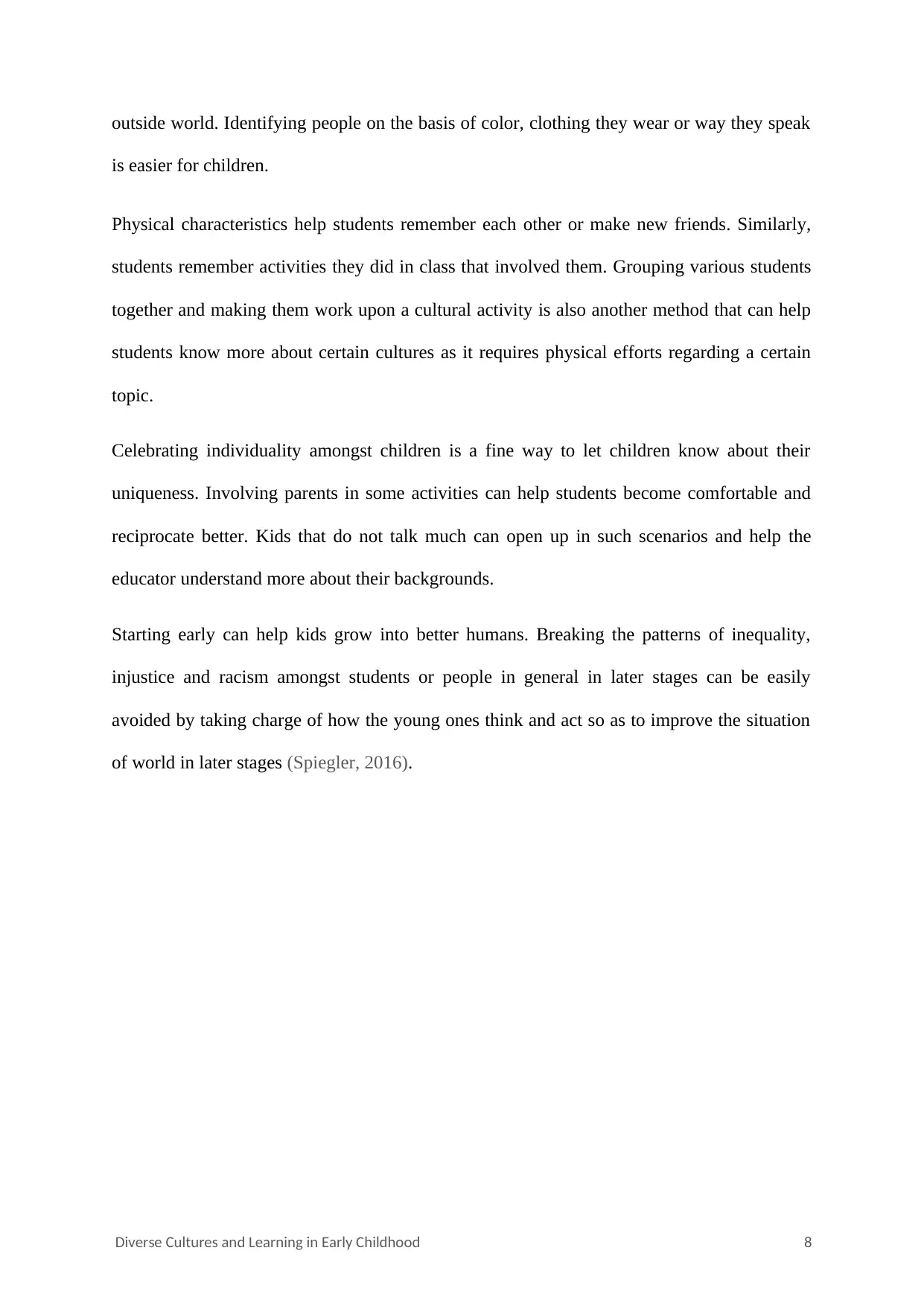
outside world. Identifying people on the basis of color, clothing they wear or way they speak
is easier for children.
Physical characteristics help students remember each other or make new friends. Similarly,
students remember activities they did in class that involved them. Grouping various students
together and making them work upon a cultural activity is also another method that can help
students know more about certain cultures as it requires physical efforts regarding a certain
topic.
Celebrating individuality amongst children is a fine way to let children know about their
uniqueness. Involving parents in some activities can help students become comfortable and
reciprocate better. Kids that do not talk much can open up in such scenarios and help the
educator understand more about their backgrounds.
Starting early can help kids grow into better humans. Breaking the patterns of inequality,
injustice and racism amongst students or people in general in later stages can be easily
avoided by taking charge of how the young ones think and act so as to improve the situation
of world in later stages (Spiegler, 2016).
Diverse Cultures and Learning in Early Childhood 8
is easier for children.
Physical characteristics help students remember each other or make new friends. Similarly,
students remember activities they did in class that involved them. Grouping various students
together and making them work upon a cultural activity is also another method that can help
students know more about certain cultures as it requires physical efforts regarding a certain
topic.
Celebrating individuality amongst children is a fine way to let children know about their
uniqueness. Involving parents in some activities can help students become comfortable and
reciprocate better. Kids that do not talk much can open up in such scenarios and help the
educator understand more about their backgrounds.
Starting early can help kids grow into better humans. Breaking the patterns of inequality,
injustice and racism amongst students or people in general in later stages can be easily
avoided by taking charge of how the young ones think and act so as to improve the situation
of world in later stages (Spiegler, 2016).
Diverse Cultures and Learning in Early Childhood 8
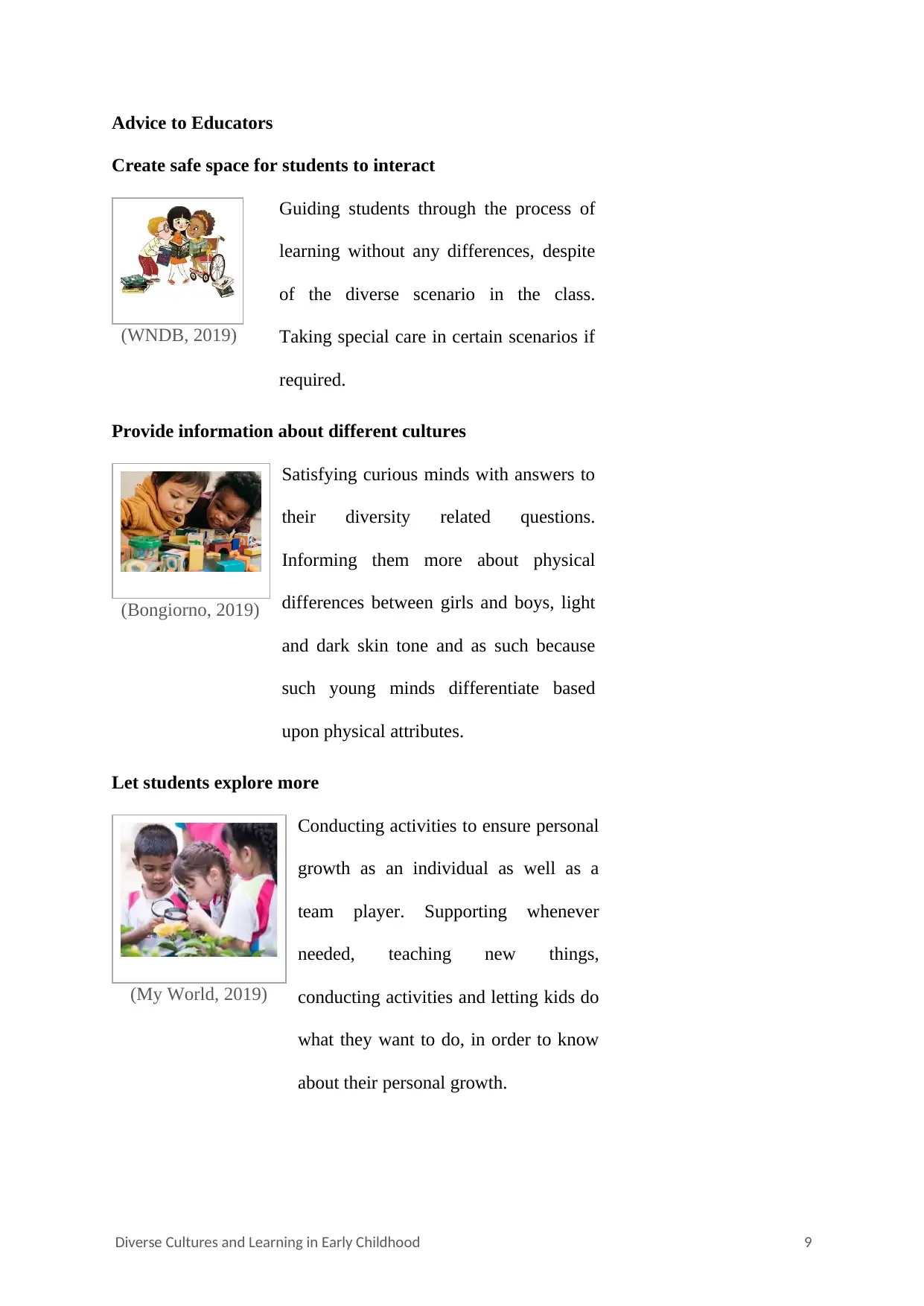
Advice to Educators
Create safe space for students to interact
(WNDB, 2019)
Guiding students through the process of
learning without any differences, despite
of the diverse scenario in the class.
Taking special care in certain scenarios if
required.
Provide information about different cultures
(Bongiorno, 2019)
Satisfying curious minds with answers to
their diversity related questions.
Informing them more about physical
differences between girls and boys, light
and dark skin tone and as such because
such young minds differentiate based
upon physical attributes.
Let students explore more
(My World, 2019)
Conducting activities to ensure personal
growth as an individual as well as a
team player. Supporting whenever
needed, teaching new things,
conducting activities and letting kids do
what they want to do, in order to know
about their personal growth.
Diverse Cultures and Learning in Early Childhood 9
Create safe space for students to interact
(WNDB, 2019)
Guiding students through the process of
learning without any differences, despite
of the diverse scenario in the class.
Taking special care in certain scenarios if
required.
Provide information about different cultures
(Bongiorno, 2019)
Satisfying curious minds with answers to
their diversity related questions.
Informing them more about physical
differences between girls and boys, light
and dark skin tone and as such because
such young minds differentiate based
upon physical attributes.
Let students explore more
(My World, 2019)
Conducting activities to ensure personal
growth as an individual as well as a
team player. Supporting whenever
needed, teaching new things,
conducting activities and letting kids do
what they want to do, in order to know
about their personal growth.
Diverse Cultures and Learning in Early Childhood 9
⊘ This is a preview!⊘
Do you want full access?
Subscribe today to unlock all pages.

Trusted by 1+ million students worldwide
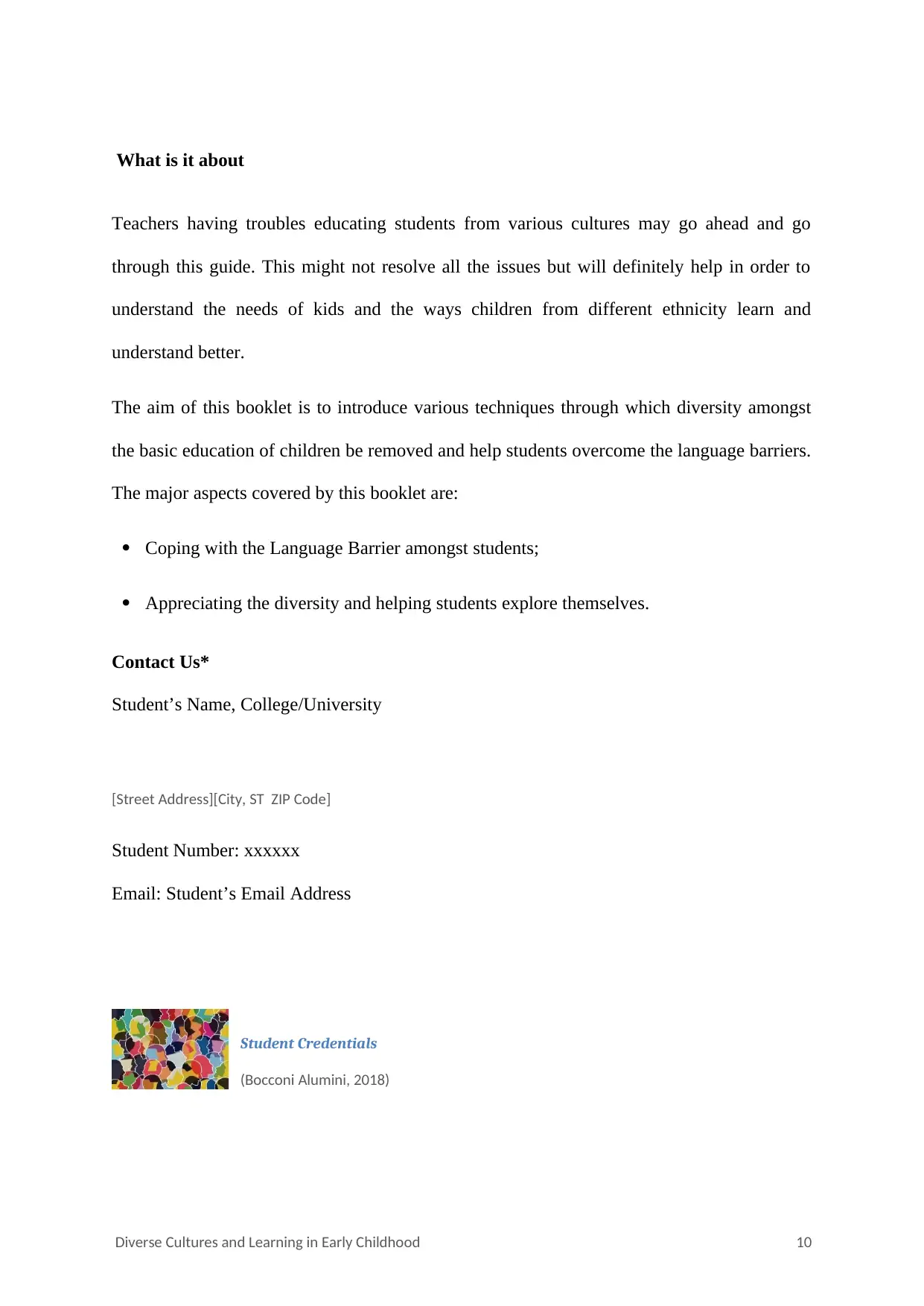
What is it about
Teachers having troubles educating students from various cultures may go ahead and go
through this guide. This might not resolve all the issues but will definitely help in order to
understand the needs of kids and the ways children from different ethnicity learn and
understand better.
The aim of this booklet is to introduce various techniques through which diversity amongst
the basic education of children be removed and help students overcome the language barriers.
The major aspects covered by this booklet are:
Coping with the Language Barrier amongst students;
Appreciating the diversity and helping students explore themselves.
Contact Us*
Student’s Name, College/University
[Street Address][City, ST ZIP Code]
Student Number: xxxxxx
Email: Student’s Email Address
Student Credentials
(Bocconi Alumini, 2018)
Diverse Cultures and Learning in Early Childhood 10
Teachers having troubles educating students from various cultures may go ahead and go
through this guide. This might not resolve all the issues but will definitely help in order to
understand the needs of kids and the ways children from different ethnicity learn and
understand better.
The aim of this booklet is to introduce various techniques through which diversity amongst
the basic education of children be removed and help students overcome the language barriers.
The major aspects covered by this booklet are:
Coping with the Language Barrier amongst students;
Appreciating the diversity and helping students explore themselves.
Contact Us*
Student’s Name, College/University
[Street Address][City, ST ZIP Code]
Student Number: xxxxxx
Email: Student’s Email Address
Student Credentials
(Bocconi Alumini, 2018)
Diverse Cultures and Learning in Early Childhood 10
Paraphrase This Document
Need a fresh take? Get an instant paraphrase of this document with our AI Paraphraser
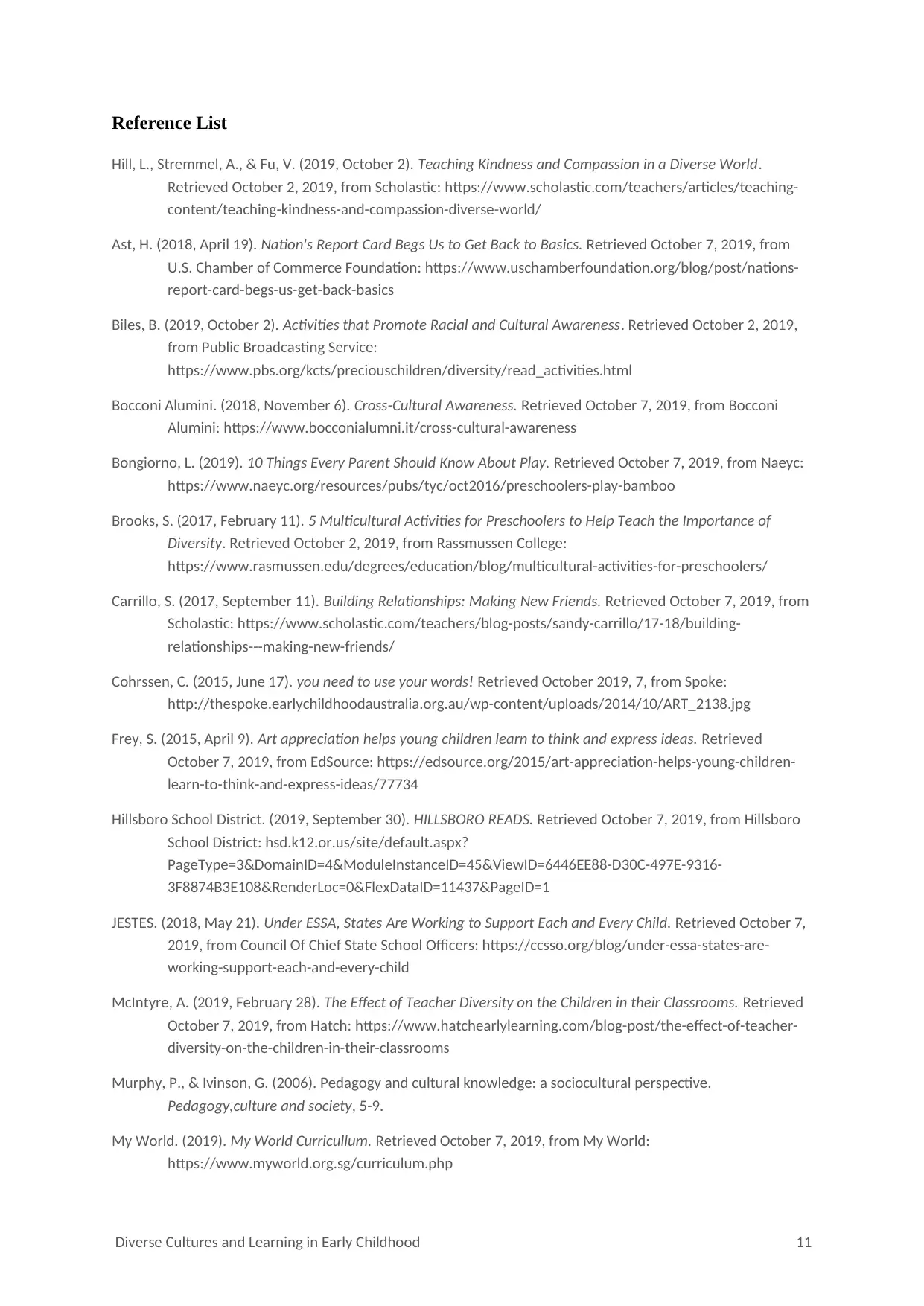
Reference List
Hill, L., Stremmel, A., & Fu, V. (2019, October 2). Teaching Kindness and Compassion in a Diverse World.
Retrieved October 2, 2019, from Scholastic: https://www.scholastic.com/teachers/articles/teaching-
content/teaching-kindness-and-compassion-diverse-world/
Ast, H. (2018, April 19). Nation's Report Card Begs Us to Get Back to Basics. Retrieved October 7, 2019, from
U.S. Chamber of Commerce Foundation: https://www.uschamberfoundation.org/blog/post/nations-
report-card-begs-us-get-back-basics
Biles, B. (2019, October 2). Activities that Promote Racial and Cultural Awareness. Retrieved October 2, 2019,
from Public Broadcasting Service:
https://www.pbs.org/kcts/preciouschildren/diversity/read_activities.html
Bocconi Alumini. (2018, November 6). Cross-Cultural Awareness. Retrieved October 7, 2019, from Bocconi
Alumini: https://www.bocconialumni.it/cross-cultural-awareness
Bongiorno, L. (2019). 10 Things Every Parent Should Know About Play. Retrieved October 7, 2019, from Naeyc:
https://www.naeyc.org/resources/pubs/tyc/oct2016/preschoolers-play-bamboo
Brooks, S. (2017, February 11). 5 Multicultural Activities for Preschoolers to Help Teach the Importance of
Diversity. Retrieved October 2, 2019, from Rassmussen College:
https://www.rasmussen.edu/degrees/education/blog/multicultural-activities-for-preschoolers/
Carrillo, S. (2017, September 11). Building Relationships: Making New Friends. Retrieved October 7, 2019, from
Scholastic: https://www.scholastic.com/teachers/blog-posts/sandy-carrillo/17-18/building-
relationships---making-new-friends/
Cohrssen, C. (2015, June 17). you need to use your words! Retrieved October 2019, 7, from Spoke:
http://thespoke.earlychildhoodaustralia.org.au/wp-content/uploads/2014/10/ART_2138.jpg
Frey, S. (2015, April 9). Art appreciation helps young children learn to think and express ideas. Retrieved
October 7, 2019, from EdSource: https://edsource.org/2015/art-appreciation-helps-young-children-
learn-to-think-and-express-ideas/77734
Hillsboro School District. (2019, September 30). HILLSBORO READS. Retrieved October 7, 2019, from Hillsboro
School District: hsd.k12.or.us/site/default.aspx?
PageType=3&DomainID=4&ModuleInstanceID=45&ViewID=6446EE88-D30C-497E-9316-
3F8874B3E108&RenderLoc=0&FlexDataID=11437&PageID=1
JESTES. (2018, May 21). Under ESSA, States Are Working to Support Each and Every Child. Retrieved October 7,
2019, from Council Of Chief State School Officers: https://ccsso.org/blog/under-essa-states-are-
working-support-each-and-every-child
McIntyre, A. (2019, February 28). The Effect of Teacher Diversity on the Children in their Classrooms. Retrieved
October 7, 2019, from Hatch: https://www.hatchearlylearning.com/blog-post/the-effect-of-teacher-
diversity-on-the-children-in-their-classrooms
Murphy, P., & Ivinson, G. (2006). Pedagogy and cultural knowledge: a sociocultural perspective.
Pedagogy,culture and society, 5-9.
My World. (2019). My World Curricullum. Retrieved October 7, 2019, from My World:
https://www.myworld.org.sg/curriculum.php
Diverse Cultures and Learning in Early Childhood 11
Hill, L., Stremmel, A., & Fu, V. (2019, October 2). Teaching Kindness and Compassion in a Diverse World.
Retrieved October 2, 2019, from Scholastic: https://www.scholastic.com/teachers/articles/teaching-
content/teaching-kindness-and-compassion-diverse-world/
Ast, H. (2018, April 19). Nation's Report Card Begs Us to Get Back to Basics. Retrieved October 7, 2019, from
U.S. Chamber of Commerce Foundation: https://www.uschamberfoundation.org/blog/post/nations-
report-card-begs-us-get-back-basics
Biles, B. (2019, October 2). Activities that Promote Racial and Cultural Awareness. Retrieved October 2, 2019,
from Public Broadcasting Service:
https://www.pbs.org/kcts/preciouschildren/diversity/read_activities.html
Bocconi Alumini. (2018, November 6). Cross-Cultural Awareness. Retrieved October 7, 2019, from Bocconi
Alumini: https://www.bocconialumni.it/cross-cultural-awareness
Bongiorno, L. (2019). 10 Things Every Parent Should Know About Play. Retrieved October 7, 2019, from Naeyc:
https://www.naeyc.org/resources/pubs/tyc/oct2016/preschoolers-play-bamboo
Brooks, S. (2017, February 11). 5 Multicultural Activities for Preschoolers to Help Teach the Importance of
Diversity. Retrieved October 2, 2019, from Rassmussen College:
https://www.rasmussen.edu/degrees/education/blog/multicultural-activities-for-preschoolers/
Carrillo, S. (2017, September 11). Building Relationships: Making New Friends. Retrieved October 7, 2019, from
Scholastic: https://www.scholastic.com/teachers/blog-posts/sandy-carrillo/17-18/building-
relationships---making-new-friends/
Cohrssen, C. (2015, June 17). you need to use your words! Retrieved October 2019, 7, from Spoke:
http://thespoke.earlychildhoodaustralia.org.au/wp-content/uploads/2014/10/ART_2138.jpg
Frey, S. (2015, April 9). Art appreciation helps young children learn to think and express ideas. Retrieved
October 7, 2019, from EdSource: https://edsource.org/2015/art-appreciation-helps-young-children-
learn-to-think-and-express-ideas/77734
Hillsboro School District. (2019, September 30). HILLSBORO READS. Retrieved October 7, 2019, from Hillsboro
School District: hsd.k12.or.us/site/default.aspx?
PageType=3&DomainID=4&ModuleInstanceID=45&ViewID=6446EE88-D30C-497E-9316-
3F8874B3E108&RenderLoc=0&FlexDataID=11437&PageID=1
JESTES. (2018, May 21). Under ESSA, States Are Working to Support Each and Every Child. Retrieved October 7,
2019, from Council Of Chief State School Officers: https://ccsso.org/blog/under-essa-states-are-
working-support-each-and-every-child
McIntyre, A. (2019, February 28). The Effect of Teacher Diversity on the Children in their Classrooms. Retrieved
October 7, 2019, from Hatch: https://www.hatchearlylearning.com/blog-post/the-effect-of-teacher-
diversity-on-the-children-in-their-classrooms
Murphy, P., & Ivinson, G. (2006). Pedagogy and cultural knowledge: a sociocultural perspective.
Pedagogy,culture and society, 5-9.
My World. (2019). My World Curricullum. Retrieved October 7, 2019, from My World:
https://www.myworld.org.sg/curriculum.php
Diverse Cultures and Learning in Early Childhood 11
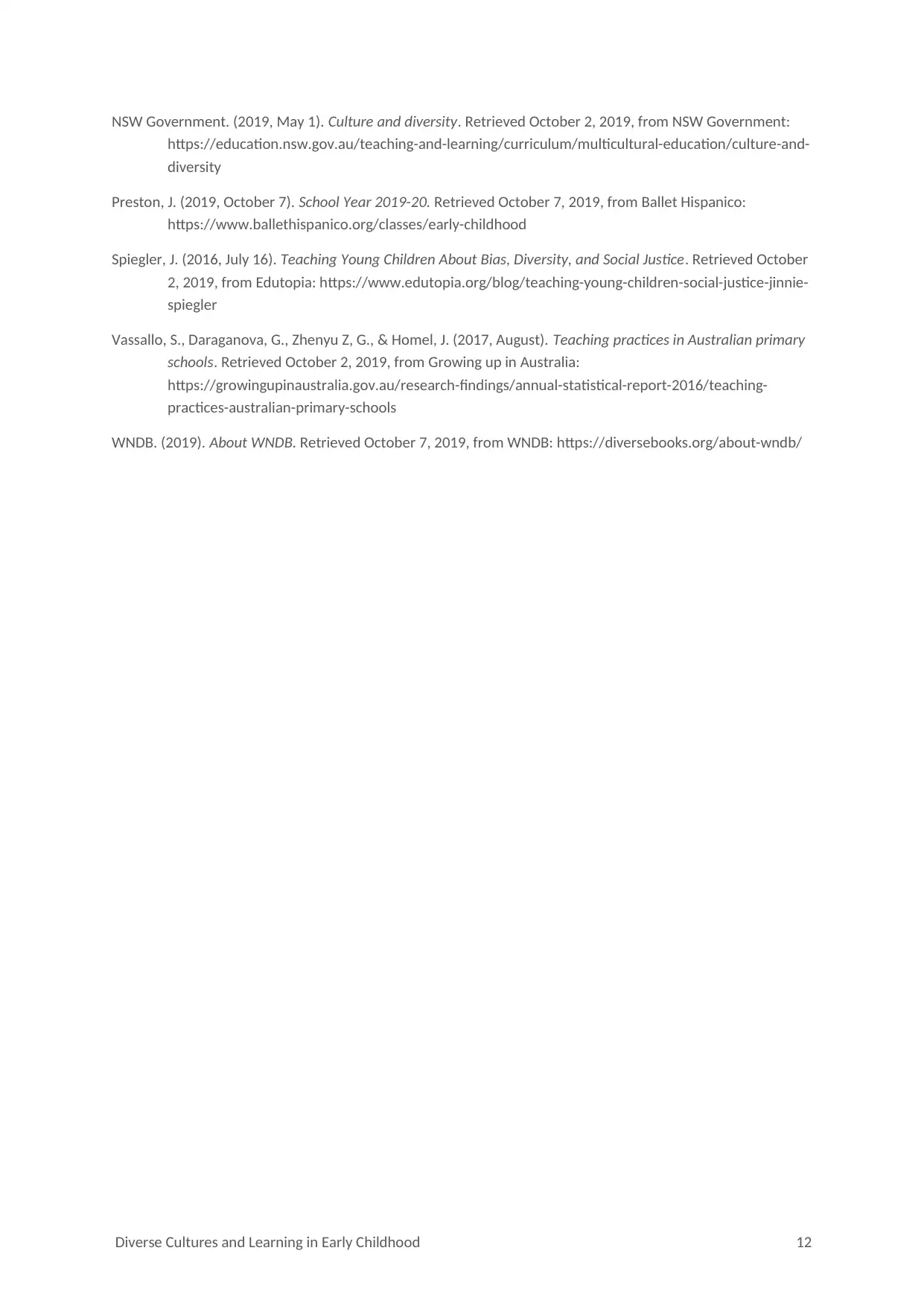
NSW Government. (2019, May 1). Culture and diversity. Retrieved October 2, 2019, from NSW Government:
https://education.nsw.gov.au/teaching-and-learning/curriculum/multicultural-education/culture-and-
diversity
Preston, J. (2019, October 7). School Year 2019-20. Retrieved October 7, 2019, from Ballet Hispanico:
https://www.ballethispanico.org/classes/early-childhood
Spiegler, J. (2016, July 16). Teaching Young Children About Bias, Diversity, and Social Justice. Retrieved October
2, 2019, from Edutopia: https://www.edutopia.org/blog/teaching-young-children-social-justice-jinnie-
spiegler
Vassallo, S., Daraganova, G., Zhenyu Z, G., & Homel, J. (2017, August). Teaching practices in Australian primary
schools. Retrieved October 2, 2019, from Growing up in Australia:
https://growingupinaustralia.gov.au/research-findings/annual-statistical-report-2016/teaching-
practices-australian-primary-schools
WNDB. (2019). About WNDB. Retrieved October 7, 2019, from WNDB: https://diversebooks.org/about-wndb/
Diverse Cultures and Learning in Early Childhood 12
https://education.nsw.gov.au/teaching-and-learning/curriculum/multicultural-education/culture-and-
diversity
Preston, J. (2019, October 7). School Year 2019-20. Retrieved October 7, 2019, from Ballet Hispanico:
https://www.ballethispanico.org/classes/early-childhood
Spiegler, J. (2016, July 16). Teaching Young Children About Bias, Diversity, and Social Justice. Retrieved October
2, 2019, from Edutopia: https://www.edutopia.org/blog/teaching-young-children-social-justice-jinnie-
spiegler
Vassallo, S., Daraganova, G., Zhenyu Z, G., & Homel, J. (2017, August). Teaching practices in Australian primary
schools. Retrieved October 2, 2019, from Growing up in Australia:
https://growingupinaustralia.gov.au/research-findings/annual-statistical-report-2016/teaching-
practices-australian-primary-schools
WNDB. (2019). About WNDB. Retrieved October 7, 2019, from WNDB: https://diversebooks.org/about-wndb/
Diverse Cultures and Learning in Early Childhood 12
⊘ This is a preview!⊘
Do you want full access?
Subscribe today to unlock all pages.

Trusted by 1+ million students worldwide
1 out of 12
Related Documents
Your All-in-One AI-Powered Toolkit for Academic Success.
+13062052269
info@desklib.com
Available 24*7 on WhatsApp / Email
![[object Object]](/_next/static/media/star-bottom.7253800d.svg)
Unlock your academic potential
Copyright © 2020–2025 A2Z Services. All Rights Reserved. Developed and managed by ZUCOL.




